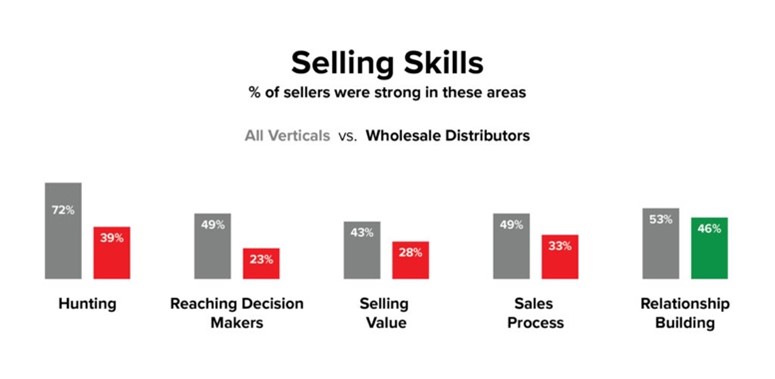By: Doug Wyatt, VP of Sales & Marketing at SPARXiQ

Sales effectiveness has increasingly become a focal point for distributors as markets have become more competitive. While record growth numbers from 2021-22 have settled into a new plateau, sales teams now face the requirement of capturing market share to sustain growth. In this environment, enhancing execution on the front lines is more critical than ever.
Training sales reps and implementing formal sales processes aren’t new ideas. Yet, few companies have historically been thrilled with the results of doing so. Over the past few years, our team at SPARXiQ has worked closely with distributors who have successfully upskilled their teams, achieving measurable gains as a result. In this article, I’ll share key strategies these companies have implemented and the significant impacts of dedicating focus to this area. We’ll also point out common hurdles and how to navigate them.
Closing The Sales Skill Gaps: A Comparative Analysis

Recently, my friend and colleague Mike Kunkle shared a comparison of sales competences in distribution versus other verticals on the NAW blog. The data points confirm what many of us know anecdotally. While distribution sellers are strong in nurturing relationships, they often lack the skills needed for hunting, reaching decision makers, selling on value, or adhering to a defined sales process.
This skill gap shows up in daily operations, with sales teams potentially spending too much time on customer relationships, at the expense of seeking new business opportunities. It’s understandable; it’s human nature to gravitate towards comfort rather than confront the friction and challenges associated with new business development. This issue isn’t simply about motivation but indicates a clear need for skill enhancement.
This comparison isn’t meant to be a dig at the hardworking folks on our sales teams. Rather, it encourages us to consider the potential of a distribution sales team if these skills gaps were addressed. What impact could we achieve if our teams were able to close these gaps and operate at an average to above average level?
Overcoming the Challenges of Traditional Sales Training Efforts
Recognizing the above skill gaps is a step forward. However, traditional training efforts – ranging from full-day classroom sessions to supplier-led product training – often ends with the question, “Okay, so what?”
Too many companies have found very little (if any) long-term benefit to sales performance from these traditional training methods. As a result, training has taken a back seat to other initiatives, such as new sales tech, adjusted compensation plans, etc.
Best Practices for Effective Skill Development
For those who are serious about upskilling and elevating their sales performance, training can’t be a one-and-done activity. Much like learning a foreign language, improving sales execution requires tackling one part of the sales conversation at a time, getting it right, and then building on that one step at a time. There is a reason we don’t see one-day foreign language learning workshops.
We’ve observed significant sales improvements by applying this logic to upskilling several distribution sales teams over the years. This involves sellers dedicating a small amount of time each week to learning best practices for a key part of the sales conversation. Then, they discuss and practice with their peers in manager-led sessions to ensure the new approaches can be applied confidently in everyday situations. This paves the way for a natural transfer to daily behaviors and the managers’ involvement enables greater accountability.
When training is done in this way, distributors often find conversations changing for the better – both internal conversations about sales and customer situations, and external conversations with customers. Most importantly, the gains are showing up in top-line sales numbers.
Achieving Measurable Impacts from Sales Skills Training
When sellers develop their skill sets using the approaches mentioned, training effectively transfers to real-world sales activities and skill gaps can be closed. We’ve observed meaningful impacts when implementing skill development programs using this week-by-week, spaced learning approach:
- A study of 81 sellers across three distributors in different industries found an average of 12.6% top-line sales growth after completing our Modern Sales Foundations program.
- A notable achievement by a $1B electrical distributor was gaining 1.8 margin points on their manually-priced sales – worth millions of dollars in annual profit – following our negotiation skills program.
- A pipe and plumbing distributor trained half of its sales force, resulting in a 2.5x improvement in new account generation among those who completed Modern Sales Foundations.
Each of these companies decided that training wasn’t simply a check-the-box obligation; they saw upskilling as a key driver of growth in their core business performance.
Overcoming Common Hurdles in Sales Skill Development
So, the above outcomes sound good and the idea of making sales skill development more than a one-off event makes sense on paper. But, like many other distribution leaders, you may have concerns about it working the same for your team. Here are the two biggest reservations we hear:
Fear of Veteran Revolt. Arguably the most common concern, this stems from distributors having seasoned sales teams and the perception that “training is for rookies.” While there is the occasional detractor, we’ve seen far more veteran sellers who jump on board and are excited about the opportunity to further refine their approaches and potentially boost their earnings.
Thinly-Stretched Managers. When you think about sales managers taking a role in training their reps, two things typically come to mind:
- Competing priorities
- A lack of experience delivering training
The reality is that managers must be involved in some way, or else your skill development efforts happen in a vacuum. When managers are given clear playbooks to follow, we’ve found that they deliver what’s needed and demonstrate organizational alignment that further drives adoption.
Out-Train to Out-Compete
If you want to take share rather than navigate the ups and downs of the market, your sellers need the skills and playbooks to execute better than your competitors. While training and skill development efforts have historically yielded mixed results, the approach outlined here has proven to be a reliable formula for breaking the cycle of ineffective training.
We encourage distribution executives to view sales training not just as an obligatory task but as a strategic investment in their team’s and company’s growth. The real question is, can you afford not to?
About the Author

Doug Wyatt
VP of Sales & Marketing at SPARXiQ
Doug Wyatt has 15 years’ experience supporting companies in distribution in improving their sales results. He currently leads Sales and Marketing at SPARXiQ, a leading analytics and sales training provider supporting wholesale distributors.

